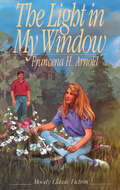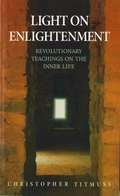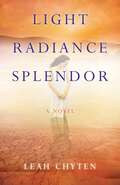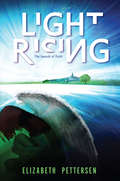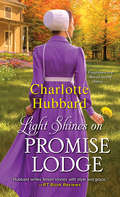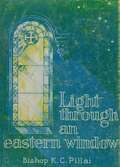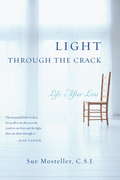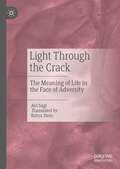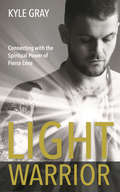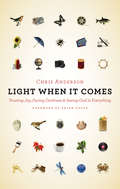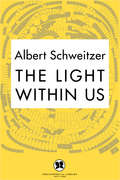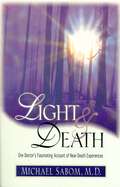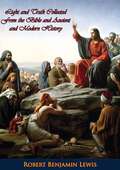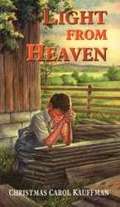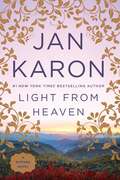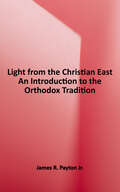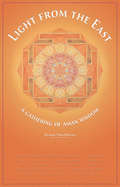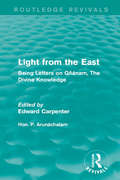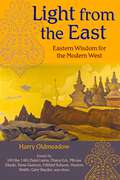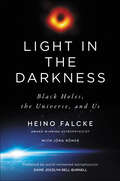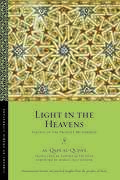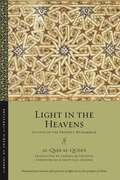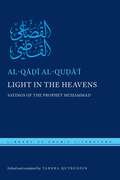- Table View
- List View
Light In My Window
by Francena H. ArnoldHope Thompson is new to the big city. However, instead of finding fulfillment in her work and service, she is bitter and struggles with herself, with God, and with her love for Stan. Sequel to the bestselling Not My Will, this dynamic story is one of searching, discovery, and peace.
Light On Enlightenment: Revolutionary Teachings On The Inner Life
by Christopher TitmussMany in the West today are familiar with the benefits offered by meditation and mindfulness, and keen to understand more about Buddhism. Written by a former journalist and Buddhist monk, Light on Enlightenment is an accessible guide to the Buddhist teachings, offering insight and inspiration for daily life, as well as a lucid guide on the path to enlightenment. Christopher Titmuss draws upon the experiences of real people to show how Buddhist teachings are relevant to the problems of Western society, and can exert a valuable influence on science, psychotherapy, green issues, our lifestyles and communities. Light on Enlightenment opens up for all of us the possibility of inner transformation and regaining control over our lives.
Light Radiance Splendor: A Novel
by Leah ChytenGold Medal IPPY Winner in Religious Fiction Finalist in the novel/fiction category of the Next Generation Indie Book Award Winner: Best Religious Fiction, International Book Award 2017 2017 USA Best Book Awards Finalist in Fiction: Religious 2017 International Book Awards Winner in Fiction: Religious The Divine Shekinah seeks deliverance from exile to heal a world desperately in need of Her wisdom. Her chosen mission keeper, three generations of kabbalists from places as diverse as a 19th century shtetl and modern day Israel/Palestine, must grapple with profound injustices and the shadows of humanity. If they choose the path of righteousness, love, and forgiveness, Her light can return to the world. Will the mission succeed? Will the divine feminine return to the world? The Shekinah calls to all of us to find our own way to &‘knit the world back together.&’
Light Rising: The Swords of Truth
by Elizabeth PettersenDriven by hate, Azelus and his evil servant-creatures will stop at nothing to wipe out the strong but peaceful Natori people from their magical land of Vale. Just as all hope seems lost for the Natoris, a mysterious stranger appears on the scene claiming he has been sent from afar to vanquish Azelus and crush his dark reign of terror. But has the stranger arrived in time? Or is it too late for him to save the Natoris from the clutches of their merciless foe?Light Rising is the first of three novels from author Elizabeth Pettersen about Vale, a world of beauty and mystery, and the winged Natori tribe living there. Elizabeth writes in a voice and style that&’s relevant to the current youth generation to deliver an entertaining tale aimed squarely at young fantasy-adventure enthusiasts. This Christian allegory illustrates the dramatic struggle between good and evil, and will draw young-adult readers to the truth about God's love and His redemption of humanity through Jesus Christ.
Light Shines on Promise Lodge: A Second Chance Amish Romance (Promise Lodge #5)
by Charlotte HubbardReaders who have fallen in love with Amish Romance legends such as Beverly Lewis and Cindy Windsmall, will be charmed by this heartfelt conclusion to Hubbard&’s Promise Lodge series, as the progressive ways of the Promise Lodge community are threatened by dark times… until the light of truth and love lifts them up… For abandoned wife Annabelle Beachey, Promise Lodge is a refuge where she's gained confidence and self-sufficiency. But she and others are dismayed when newly arrived Bishop Clayton King claims the community is too progressive and sets out to change its ways. Worse, her husband, Phineas returns, expecting her to give up her faith as he has. And he won't leave Promise Lodge without her . . . But little by little, Annabelle's determination and new forthrightness make Phineas realize his mistakes—and truly hear his wife for the first time. Meanwhile, Annabelle finds herself feeling compassion—and even renewed love—for her newly humble, more caring husband. And as Bishop Clayton's attempt to control Promise Lodge threatens everything its residents have built, Phineas and Annabelle must work together with unshakeable courage to save their new home—and their opportunity for forever happiness. Praise for Promise Lodge &“Hubbard firmly grounds the storyline in the principle of Amish grace.&”—Publishers Weekly &“Hubbard writes of healing and brave new beginnings from a refreshingly feminist perspective.&”—Booklist (starred review)
Light Through an Eastern Window
by Bishop K. C. PillaiFirst published in 1963, this book by Bishop K. C. Pillai was written on the urging of many of his listeners to put his teachings into book form, "so that more Christians may be encouraged to trust in the Word of God, and believe more deeply through understanding." He explains in his Introduction that he was unable to put all of his teachings into one book at this time due to time constraints, but with this volume intends to "touch upon some of the portions of the Bible which my listeners tell me have been the most interesting and inspiring."A wonderful book for any reader who seeks to know and understand the Word of God...
Light Through the Crack
by Sue MostellerA deeply moving and engaging work of Christian spirituality in the tradition of Henri Nouwen, written by his close friend and literary executrix.Sue Mosteller has had a rich life as a spiritual adventurer and as a member and leader of L'Arche Community, where she first met the great spiritual writer Henri Nouwen. In Light Through the Crack, she tells her own story and the stories of the people she has known throughout her life. She writes about her family and her upbringing; the fifty years she has spent with the Sisters of St. Joseph; her thirty years of involvement with L'Arche Daybreak Community, where people with disabilities and those who assist them create a home together; and her close, twenty-year friendship with Nouwen. With grace and humor she explores the relationships she has formed and the difficulties that go with them. Through her varied experiences, she has learned that it is impossible to live with people over the long term and hide your flaws and vulnerabilities. Leonard Cohen once wrote in a song: "There is a crack in everything/That's how the light gets in." Combining revealing memoir and the inspirational stories of others, Mosteller brings to life the meaning of that resonant phrase and illuminates why human weaknesses, the "cracks" in our personalities, are actually the greatest sources of light for the world.
Light Through the Crack: The Meaning of Life in the Face of Adversity
by Avi SagiAn epidemic such as COVID-19 challenges life’s very order and meaning, interferes in our relations with others, and breaks apart our routine. It raises many questions in the realms of ethics, politics, theology, psychology, and beyond. Perhaps more than anything else, it prompts us to ponder: what does this encounter with widespread anguish and distress imply about the human self-perception as sovereign rulers of Earthly life?In this book, renowned thinker Avi Sagi explores the existential matters brought to the philosophical fore by the pandemic. He shows how we, when thrown into the terror of a crisis, carry the traditions, values, ideals, hopes, failures, and habits that constitute our lives, all shaping the way we grapple with questions seemingly resolved. We may then find that the crack that opens up at times of sorrow can also be a moment of discovery. Sagi analyzes various ways of confronting the crack now at the heart of our existence. What emerges is a clear normative statement: We are not only what we were but also what we can be, and we can create a world of meaning by standing together with others.
Light Up New York
by Natalie GrantJoin twins Mia and Maddie and their sidekick little sister, Lulu, as they travel the country finding adventure, mystery, and sometimes mischief along the way. Together with their famous mother, singer Gloria Glimmer, and their slightly wacky nanny Miss Julia, the sisters learn lessons about being good friends, telling the truth, and a whole lot more.In this fourth book in the Faithgirlz Glimmer Girls series, the Glimmer family is headed to the Big Apple—New York City! Gloria has been asked to perform a concert in Times Square and the whole family joins her. Miss Julia immediately starts planning a sightseeing trip for the sisters that will be better than all the rest, but plans never turn out exactly as they imagine when the Glimmer girls are involved. So what happens when sibling rivalry, random acts of kindness, and a little mystery all meet up at some of the most famous sights in New York City?
Light Warrior: The Spiritual Power of Fierce Love
by Kyle GrayWithin the light no shadow can existA light worker is anyone who has heard the internal call to make a difference in the world. A light warrior is someone who chooses to respond to the call. Light Warrior is a manual for those who are ready to take action but may be feeling sensitive, powerless and fearful of the unknown.In this book, angel expert Kyle Gray encourages you to identify the fears holding you back and gives you the spiritual armoury to help you become the light warrior you were born to be. You’ll be introduced to a number of warrior workouts that will help you to: •drop the shields of fear and accept support •create a loving connection with your angels and guides •increase your psychic protection and assertive voice •overcome the fear of persecution •step into the magic of ceremonyAre you ready to overcome your blocks, create internal shifts and embrace the light within? Let Light Warrior show you the way!
Light When It Comes: Trusting Joy, Facing Darkness, and Seeing God in Everything
by Chris AndersonOn finding joy and spiritual meaning in life's small moments We all have moments of joy, moments that move us somehow, spiritual moments that we can't quite put a finger on. But then we rush on and soon forget. In this book Chris Anderson encourages us to remember and share such moments. What he writes will inspire readers who are hurting, doubting, or searching to find wisdom and meaning in their lives. Drawing on an ancient prayer tradition, the examen of conscience, Anderson spurs readers to take stock of their own experiences. He shows how the examen can serve as a simple but powerful way to remember moments of light, of struggle, of joy. And however small or fleeting these moments are, through them God is always calling and meeting us.
Light When It Comes: Trusting Joy, Facing Darkness, and Seeing God in Everything
by Chris AndersonOn finding joy and spiritual meaning in life's small moments We all have moments of joy, moments that move us somehow, spiritual moments that we can't quite put a finger on. But then we rush on and soon forget. In this book Chris Anderson encourages us to remember and share such moments. What he writes will inspire readers who are hurting, doubting, or searching to find wisdom and meaning in their lives. Drawing on an ancient prayer tradition, the examen of conscience, Anderson spurs readers to take stock of their own experiences. He shows how the examen can serve as a simple but powerful way to remember moments of light, of struggle, of joy. And however small or fleeting these moments are, through them God is always calling and meeting us.
Light Within Us
by Albert SchweitzerThe selections contained in this volume were made by Richard Kik. The original edition Vom Licht in uns was published by Verlag J. F. Steinkopf, Stuhgart. It contains sayings of things highly spiritual nature as well as a description of the life of Richard Kik. One such selection is The beginning of all spiritual life is fearless belief in truth and its open confession. Albert Schweitzer (14 January 1875 - 4 September 1965) was a German-French theologian, musician, philosopher, and physician. He was born in Kaysersberg in the province of Elsass-Lothringen (Alsace-Lorraine), at the time in the German Empire. Schweitzer challenged both the secular view of Jesus as depicted by historical-critical methodology current at his time in certain academic circles, as well the traditional Christian view, depicting a Jesus Christ who expected and predicted the imminent end of the world. He received the 1952 Nobel Peace Prize in 1953 for his philosophy of Reverence for Life expressed in many ways, but most famously in founding and sustaining the Albert Schweitzer Hospital in Lambarn, now in Gabon, west central Africa (then French Equatorial Africa). As a music scholar and organist, he studied the music of German composer Johann Sebastian Bach and influenced the Organ reform movement (Orgelbewegung). Schweitzer's passionate quest was to discover a universal ethical philosophy, anchored in a universal reality, and make it directly available to all of humanity. This is reflected in some of his sayings, such as: Until he extends his circle of compassion to include all living things, man will not himself find peace. I don't know what your destiny will be, but one thing I do know: the only ones among you who will be really happy are those who have sought and found how to serve.
Light and Death: One Doctor's Fascinating Account of Near-Death Experiences
by Michael SabomBegun in 1994, The Atlanta Study is the first comprehensive investigation of its kind into near-death experiences (NDEs). The study's name hardly captures what lies behind it: life-and-death dramas played out in operating rooms and hospital beds--and simultaneous events unseen by medical personnel but reported with astonishing clarity and conviction by nearly 50 individuals who returned from death's door. Now the founder of The Atlanta Study, Dr. Michael Sabom reveals their impact on the people who have experienced them. From both medical and personal perspectives, he shares the electrifying stories of men and women from all walks of life and religious persuasions. He explores the clinical effect of the NDE on survival and healing and discloses surprising findings. He questions some common conclusions about NDEs. And he scrutinizes near-death experiences in the light of what the Bible has to say about death and dying, the realities of light and darkness, and the Gospel of Jesus Christ.
Light and Truth Collected From the Bible and Ancient and Modern History: Collected From The Bible And Ancient And Modern History: Containing The Universal History Of The Colored And The Indian Race, From The Creation Of The World To The Present Time
by Robert Benjamin Lewis"Light and Truth Collected From the Bible and Ancient and Modern History" by Robert Benjamin Lewis is a profound exploration of the intersection between biblical teachings and historical narratives. Published in the 19th century, this work delves into the rich tapestry of human history, drawing connections between the spiritual wisdom of the Bible and the recorded events of ancient and modern civilizations.Lewis meticulously compiles insights from various historical sources, presenting a comprehensive view of humanity's journey through time. He examines the moral and ethical lessons embedded in biblical stories and correlates them with significant occurrences and figures from history. This book is a treasure trove of knowledge for those interested in understanding how religious texts and historical events interplay to shape our world.Through his detailed research and thoughtful analysis, Lewis aims to illuminate the timeless truths and enduring wisdom that transcend cultures and epochs. "Light and Truth" serves as both a historical reference and a spiritual guide, offering readers a deeper appreciation of the interconnectedness of faith and history.
Light from Heaven
by Christmas Carol KauffmanJoseph Armstrong's father showed more concern for his farms and horses than he did for his wife and children. Work was first. Mishaps were dealt with harshly. Praise was a foreign language. The family suffered cruel scorn, rejection, and deprivation. All the while, Bennet Armstrong hypocritically portrayed himself to others as flawlessly pious. The Armstrong home was a potential hotbed for bitterness and emotional desolation. Thankfully, a devout mother bridged the gap, loving her children, praying fervently for their safety and salvation. Annie Armstrong's prayers were heard. Joseph came to trust his kind heavenly Father who helped him love and forgive and rise above his circumstance to a life of purpose and peace. This story, sometimes heartrending sometimes heartening points to the one true hope for all man's miseries, Jesus Christ, the true Light From Heaven.
Light from Heaven (A Mitford Novel #9)
by Jan KaronThe ninth novel in the beloved Mitford series, by the bestselling author of At Home in Mitford and Somebody Safe with Somebody Good Father Tim Kavanagh has been asked to "come up higher" more than once. But he's never been asked to do the impossible--until now. The retired Episcopal priest takes on the revival of a mountain church that's been closed for forty years. Meanwhile, in Mitford, he's sent on a hunt for hidden treasure, and two beloved friends are called to come up higher. As Father Tim finds, there are still plenty of heartfelt surprises, dear friends old and new, and the most important lesson of all: It's never too late.
Light from the Christian East: An Introduction to the Orthodox Tradition
by James R. Payton Jr.The Word Guild Canadian Christian Writing Awards winner "Do they really pray to icons?" "Why do they use incense?" "What do they believe?" To many people, the Orthodox Christian tradition (or Eastern Orthodoxy) seems unfamiliar and mysterious. Yet this tradition is arguably the most faithful representative of early Christianity in existence today and numbers roughly 250 million adherents worldwide. What's more, a steady stream of evangelical Christians has been entering the Orthodox Church in recent decades. Isn't it time we gained a deeper understanding of Orthodoxy? In Light from the Christian East, James Payton gives us just that. With a sympathetic eye and even hand, he ushers readers into the world of Orthodox Christianity--its history, theology, and religious practices. In doing so, he clears the confusion and misunderstandings that often prevent non-Orthodox Christians from fully appreciating the riches of this ancient tradition. This book is essential reading for anyone interested in Orthodox Christianity.
Light from the East
by Frank MachovecThe great spiritual traditions of Asia in a remarkably compact format. Included are Indian, Tibetan, and Zen Buddhism, Hinduism, Taoism, Yoga, T'ai Chi Ch'uan, Shinto, Confucianism, Feng Shui, and Falun Gong, with brief discussions and excerpts from key works like The Tibetan Book of the Dead and The Book of Five Rings, including the complete I Ching and The Book of Tao. Excellent for casual reading, classroom surveys, and for anyone wanting a broad view of how the Asian ways complement and reflect each other. Fully indexed.Frank MacHovec, a retired psychologist, has been a student of Eastern philosophies for decades and has previously published translations of several sacred works. He lives in eastern Virginia.
Light from the East: Being Letters on Gñanam, The Divine Knowledge (Routledge Revivals: The Collected Works of Edward Carpenter)
by Hon. P. ArunáchalamLight from the East collates letters between Hon. P. Arunáchalam of the legislative council of Ceylon and Edward Carpenter, which expand on issues of the Gñanam or divine knowledge. Carpenter edited these letters for publication in 1927 as well as writing additional articles on issues such as desire, birth control and bisexuality in relation to the customs of Ceylon and religious laws of Hinduism to give the reader a broad insight into the religion. This title will be of interest to students of sociology, anthropology and religious studies.
Light from the East: Eastern Wisdom for the Modern West
by Harry OldmeadowThis is a collection of writings about the spiritual meeting of East and West in the modern world including articles by the Dalai Lama, Huston Smith, Frithjof Schuon, Thomas Merton, Titus Burckhardt, Ananda Coomaraswamy, Diana Eck, Gary Snyder and Aldous Huxley. Highlighting aspects of Hinduism, Buddhism, and Taoism that have proved most attractive to Western seekers, it explores the similarities and differences between Eastern and Western traditions while emphasizing respect amongst the adherents of different faiths.
Light in the Darkness: Black Holes, the Universe, and Us
by Heino Falcke Jörg RömerAn astrophysicist chronicles his quest to photograph a black hole and reflects on its spiritual ramifications in this international-bestselling memoir.On April 10, 2019, award-winning astrophysicist Heino Falcke presented the first image ever captured of a black hole at an international press conference—a turning point in astronomy that Science magazine called the scientific breakthrough of the year. That photo was captured with the unthinkable commitment of an intercontinental team of astronomers who transformed the world into a global telescope. While this image achieved Falcke’s goal in making a black hole “visible” for the first time, he recognizes that the photo itself asks more questions for humanity than it answers.Light in the Darkness takes us on Falcke’s extraordinary journey to the darkest corners of the universe. From the first humans looking up at the night sky to modern astrophysics, from the study of black holes to the still-unsolved mysteries of the universe, Falcke asks, in even the greatest triumphs of science, is there room for doubts, faith, and a God? A plea for curiosity and humility, Light in the Darkness sees one of the great minds shaping the world today as he ponders the big, pressing questions that present themselves when we look up at the stars.
Light in the Heavens: Sayings of the Prophet Muhammad (Library of Arabic Literature #40)
by al-Qadi al-Quda'iHumanitarian lessons and practical insights from the prophet of Islam <p><p>The words of Muhammad, messenger of God and prophet of Islam, have a special place in the hearts of his followers. Wielding an authority second only to the Qur'an, they are cited by scholars in a vast array of disciplines—including law, theology, metaphysics, poetry, grammar, history, and medicine—and are quoted by Muslims to one another in their daily lives. Light in the Heavens by al-Qadi al-Quda'i, a Sunni judge in the Fatimid court in Egypt, is an outstanding example of a compilation of these sayings, known as hadiths, that circulated orally and were later assembled and written down. From North Africa to India, generations have used Light in the Heavens as a teaching text for children as well as adults, and many of its 1,200 sayings are familiar to individuals of diverse denominations and ethnicities. For Muslims—who consider Muhammad’s teachings the fount of wisdom and the beacon of guidance in all things, mundane and sublime—these sayings provide a direct window into the inspired vision of one of the most influential humans to have walked the Earth.
Light in the Heavens: Sayings of the Prophet Muhammad (Library of Arabic Literature #40)
by al-Qāḍī al-QuḍāʿīHumanitarian lessons and practical insights from the prophet of IslamThe words of Muhammad, messenger of God and prophet of Islam, have a special place in the hearts of his followers. Wielding an authority second only to the Qur'an, they are cited by scholars in a vast array of disciplines—including law, theology, metaphysics, poetry, grammar, history, and medicine—and are quoted by Muslims to one another in their daily lives. Light in the Heavens by al-Qadi al-Quda'i, a Sunni judge in the Fatimid court in Egypt, is an outstanding example of a compilation of these sayings, known as hadiths, that circulated orally and were later assembled and written down. From North Africa to India, generations have used Light in the Heavens as a teaching text for children as well as adults, and many of its 1,200 sayings are familiar to individuals of diverse denominations and ethnicities. For Muslims—who consider Muhammad’s teachings the fount of wisdom and the beacon of guidance in all things, mundane and sublime—these sayings provide a direct window into the inspired vision of one of the most influential humans to have walked the Earth. An English-only edition.
Light in the Heavens: Sayings of the Prophet Muhammad (Library of Arabic Literature #8)
by al-Qāḍī al-QuḍāʿīSayings of the Prophet Muhammad, wielding an authority second only to the Qur'an.The words of Muhammad (d. 11/632), God's messenger and prophet of Islam, have a special place in the hearts of his followers. Wielding an authority second only to the Qur'an, Muhammad’s hadith are cited by scholars as testimonial texts in a vast array of disciplines—including law, theology, metaphysics, poetry, grammar, history, and medicine—and are quoted by Muslims to one another in their daily lives.Assembling Muhammad’s words has been a major preoccupation for scholars throughout the fourteen centuries since his death, resulting in an abundance of compilations. Among the legally-grounded collections, which aimed to guide the community in its practice of religious law and ritual worship, one which stands out in particular is Light in the Heavens (Kitab al-Shihab) by al-Qadi al-Quda'i, a Shafi'i judge in the Fatimid court in Egypt. The collection’s overall conceptualization is distinctively ethical and pragmatic, and offers humanitarian lessons and practical insights with universal appeal.From North Africa to India, generations have used Light in the Heavens as a teaching text for children as well as adults, and many of its 1200 sayings are familiar to individuals of diverse denominations and ethnicities. For Muslims—who consider Muhammad’s teachings the fount of wisdom and the beacon of guidance in all things, mundane and sublime—these sayings provide a direct window into the inspired vision of one of the most influential humans to have walked the Earth.A bilingual Arabic-English edition.
